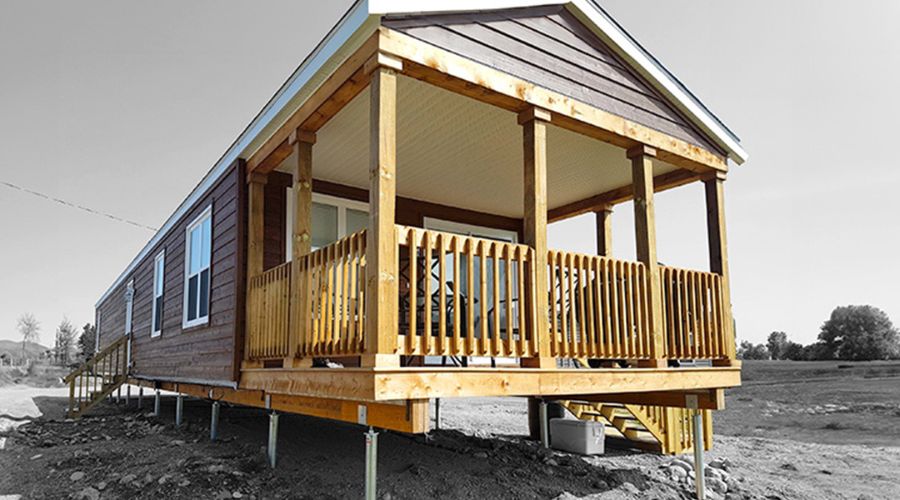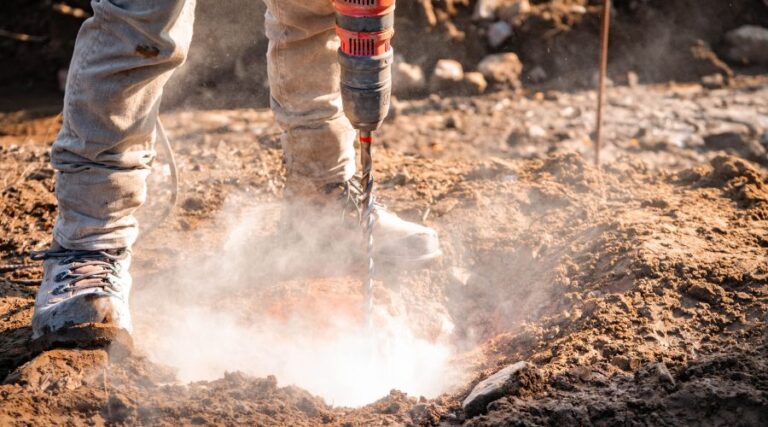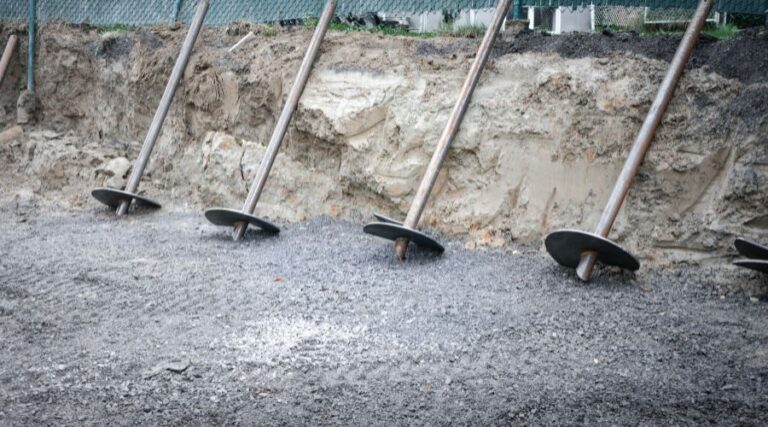Poured concrete and concrete blocks are among the most common foundation types—but they can also cause significant problems in your basement over time. Many of these issues can be corrected, or even avoided entirely, by opting for a helical pile foundation.
- In this article, you’ll discover the main benefits of a screw-pile foundation, how installation works, and what kind of budget you should plan for.
More and more homeowners and builders are turning to helical piles, which offer a fast, clean, and more durable solution than traditional concrete foundations. Helical piles can be used for a wide range of projects: garden sheds, new cottages, concrete foundation repairs, gazebos, and more. In other words, the sky is the limit!

What Are the Benefits of a Helical Pile Foundation?
Not all helical piles are created equal. Let’s start with a quick definition. A helical pile is a manufactured steel foundation consisting of helix-shaped bearing plate(s) welded to a central shaft that is rotated into the ground. Helical piles come in various sizes and configurations, each designed to support different types of structures.
To get the most out of this type of foundation, it’s essential to choose high-quality piles and have them installed by experienced professionals.
You can expect the following benefits:
- They are affordable.
- Installation is quick (a few hours).
- They are reusable (they can be removed and reinstalled elsewhere).
- No excavation is required, which protects ecosystems and saves earth-moving costs.
- They do not disturb the surrounding landscape.
- They are ideal for tight or difficult-to-access areas.
- They are appropriate for various soil types, including clay, sand, and rock.
- They have a lifespan of up to 150 years.
Environmental Advantages of Screw Piles
If you're looking for a foundation system that leaves a smaller footprint, helical piles are an excellent solution. Unlike concrete foundations, which require extensive excavation and curing, screw piles minimize environmental disruption. There's no need for heavy earth-moving equipment or large amounts of concrete, reducing both emissions and waste. Therefore, helical piles are ideal for environmentally sensitive sites.
How Do Helical Piles Work?
Set at regular intervals, they are attached to the house by steel supports. The weight of the house is transferred and evenly distributed over the piles.
One of the most compelling advantages of screw piles is that they go deep into the ground, below the frost line, which is 7 to 8 feet deep. That’s what makes them so stable.
- They are built from structural-grade rolled steel.
- The welds are clean and consistent on the top and bottom of the helix.
- There is no warping of the helix plate and it has smooth edges.
- It is CCMC-approved (Canadian Construction Materials Centre).
If these benefits sound appealing to you, please ask for quotes from local businesses.

What Can You Build on Screw Piles?
Screw piles are available in a variety of sizes and they can support different loads. Therefore, construction possibilities are endless, including:
- Homes and cottages
- Decks
- Solar panels
- Sunrooms
- Docks
- Garages
- Sheds
- Fences
What’s even more interesting is that helical piles may help you save money compared to a concrete foundation. Request quotes to compare prices.
What Are the Steps of a Successful Helical Piles Installation?
Screw piles can be used to reinforce existing foundations, or to replace a concrete foundation altogether.
Usually, in both cases, the job is entrusted to professionals. It is very important that you do not try to install them yourself because:
- Specialized equipment is needed.
- The depth, angles, and distances between piles have to be decided by an engineer.
Professionals will come to your land or house and calculate how many piles are needed, depending on the weight of the building and soil type. Once they are installed professionally, helical piles offer long-term reliability. They don’t settle or shift the way concrete sometimes does. They are resistant to rust and corrosion when made from galvanized steel. They won’t crack, rot, or degrade over time. This means fewer repairs down the road and greater peace of mind for you!
Here is a summary of the main installation steps:
1.Know the load-bearing capacity you need
Installers need to know how much weight the helical piles have to support. To determine the load, you have to know what you are going to use the space for. A garage will need a bigger load-bearing capacity than a deck, for example.
2.Assessment
An engineer will visit your home to assess your soil in order to choose the right piles for a sturdy construction. Then you’ll be able to get the layout plan and ask for a permit, if the city where you live requires one. Engineers can not only select the right load-bearing capacity and determine the spacing between them, but also advise the installers throughout the project.
3.Installation
Screw piles installers mark the ground where the piles should go. Then they start digging, using hydraulic equipment to drive the piles. This equipment allows the screw piles to be installed below the frost line. Contractors generally use multi-powered torque heads and excavators. Smaller machines are also available if your backyard is difficult to access.

How Much Should You Budget for a Helical Pile Foundation ?
It’s impossible to determine a precise price for installing piles. So much goes into the price! There’s no one-size-fits-all answer.
- The basic price of a quality screw pile is around $100-$260.
A rough estimate of the spacing between two piles is 8 to 10 feet. This should give you an idea of the number of helical piles needed, and therefore the cost.
The soil type and the site, for instance, will impact the number of screw piles needed and the work to be done. Drilling will be harder in some soil types and will take up more time.
The price for a terrace, dock, garage or house is not the same, because of the weight to be supported.
All the following factors can also increase the costs:
- The grade of the pile.
- The quality (galvanized steel or not, for example).
- The length of the shaft.
- The type of soil.
- Average labor rates in your area.
- Customization, when necessary.
In general, choosing piles over concrete foundations helps you to save on labor costs because installation takes only a few hours. Moreover, no landscaping is needed once they are installed, which will help you save more money.
High-quality helical piles are sold directly by specialized companies. Here are some general pricing guidelines.
| Helical Piles for | Average price |
|---|---|
| Small structures | $100 to $175 per installed pile |
| Medium structures | $175 and up per installed pile |
| Heavy structures | $260 and up per installed pile |
Choosing qualified professionals who offer competitive prices can make a big difference in your budget. While price should not be the only criterion you look into when analysing quotes, it’s definitely one of the most important.
What to Do if Your House Has Foundation Damage ?
Many homeowners don’t give much thought to what lies beneath their homes, until problems start to appear. Over time, traditional concrete foundations can crack, shift, or settle unevenly due to factors like soil movement, frost heave, or poor drainage. These issues can lead to structural instability and costly repairs.
Are you struggling with uneven floors? Do you see huge gaps on your windows and door frames? Helical piles are invaluable for repairing such structural issues. They can definitely restore stability to the structure of your home.
If you are unsure your house has foundation damage, look for these signs:
- Cracks in foundation walls.
- Diagonal cracks along upstairs walls, doors, and windows.
- Windows that stick open.
Foundation damage could be the cause of all your problems. A pile system can level your damaged foundation with minimal disruption to your home.
Helical piles will be attached to the foundation footing of your home. The weight of your house will then be transferred to a deeper and more stable part of the soil.
In any case when foundation damage is suspected, it may be useful to consult an engineer to assess the specific needs of your home. They can help you determine whether it’s necessary to add screw piles to a concrete foundation.
Get Quotes for a Helical Pile Foundation at a Competitive Price!
Helical piles are a great technology that saw the light of day to offset the problems of concrete. Versatile, they can be used for a host of projects, home additions and reinforcements to existing structures. With Screw Piles Quotes, you can compare prices from 3 professionals and choose the best.
- Fill out our form in just 2 minutes and start receiving quotes for your helical pile foundation. It's free and there's no obligation.
Screw piles are fast to install, environment-friendly and have immediate load-bearing capacity, which makes them a fantastic investment.


